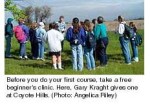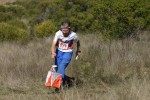Build Up Those Quads
by
Many runners and orienteers have knee problems, and one of the best ways to prevent knee injuries, and to protect an already injured knee (e.g., a torn meniscus or degenerative joint disease), is to build up the quadriceps femoris, commonly known as the quads, the group of the four large muscles on the anterior, or front side, of the thigh. The quads are the main muscles that extend, or straighten, the knee, and they are essential in running and hill climbing.
The knee is inherently a very unstable joint. It basically consists of two relatively flat bones just sitting on top of each other, the femur or thigh bone resting on the tibia or shin bone. These two bones form the knee joint, and are only held together by ligaments and muscles. By increasing the strength and size of the quads, the main muscle group around the knee, one can provide much better control of the knee, which will help prevent injuries, and help protect any damaged cartilage you may have in the knee.
After my prolonged knee injury, which was an impaction fracture of the distal femur and torn medial meniscus, I went to see Dr. Michael Dillingham, a sports orthopedist who is also the team doctor for the San Francisco 49'ers. He sent me to Lisa Giannone, owner of Active Care Physical Therapy and Sports Medicine Fitness Center in San Francisco. She instituted a program of rehabilitation for my knee which has been extremely successful, and I am now able to compete almost at the level I was at before the injury.
The major effort in rehabilitation was to increase the strength and bulk of the quads, and this was mainly done with isometric exercises. She feels that sufficient strength cannot be obtained by aerobic activity alone, because in order to develop this strength by active exercise such as running, one is prone to overtraining and injury. Therefore, I did, and continue to do, the following exercises two to three times per week.
- Quad sets
Sit on the floor with the injured or weak leg extended and the other knee flexed. Contract the quads of the affected leg as tightly as you can, trying to straighten out the knee as much as possible. Hold this for 10 seconds, rest for 2 seconds, and repeat for total of 30 to 40 repetitions. - Straight leg raises
Start like you do for the quad sets, but in addition to straightening the leg, raise it off the ground about 2 to 3 inches. Hold for 6 seconds, rest for 2 seconds, and do 3 sets of 15 to 20 reps. - Squats
This is the most important, and most difficult, of the exercises. If you do these properly, your quads will really begin to burn.- Position 1: Stand up with your feet placed slightly wider than your shoulders. Stick out your butt, and squat down until your knees are almost at a 90 degree angle. Keep your butt back and down. Put most of your weight on your heels. Hold that position for 30 seconds to begin with, and work up to 90 or 120 seconds. At the end of each hold, do 10-15 shallow knee bends flexing and extending your knee while keeping your butt back and your back straight. Repeat 3 times.
- Position 2: Start like position 1, but bend forward with your arms extending out, flex at the hip so your chest is parallel to the floor, and keep your butt back and knees flexed about 90 degrees. Hold for 30 seconds. At the end of each hold, do 10 repetitions of shallow knee bends.
- Position 3: Start like position 1, but this time reach back with your arms and head through your legs, and hold for 30 seconds. At the end of each hold, do 15 repetitions of singing your arms and trunk back and forth through your knees, keeping your butt back and knees flexed.
- Pseudo-hops: Start like position 1, but then extend your knees quickly like you are going to jump or hop, but keep your toes on the ground. Do 10 to 30 pseudo-hops before, after, or both before and after your squats. I have a routine of 30 pseudo-hops, 90 second position 1 hold, 15 reps, 15 pseudo-hops, 30 seconds of position 2, 10 reps, 12 pseudo-hops, 30 seconds of position 3, 15 reps, 20 pseudo-hops, and a 30 second position 1 hold, for about 6 minutes, and I do 3 sets with a 90 second rest between sets. However, it took me about 4 months to work up to that level. The first time I tried position 3, I fell flat on my face, and my quads were like jelly.
- Wall holds
Stand up, put your back against a wall, and squat down until your knees are almost at 90 degrees. Hold for 30 seconds, and work up to 2 minutes, with 3 sets. - Lunges
Extend your left leg forward, and drop down so your right knee almost touches the ground. Then rise up and extend your right leg forward and drop your left knee. Do about 10 to 15 lunges in one direction, and turn around and do another 10 to 15 in the opposite direction. Repeat each set 3 times with a 1 minute rest between sets. You can add 5 to 10 pound weights in your hands after you develop enough strength. - Hamstring bridges
Lie on the floor with your knees slightly flexed and heels on the floor. Raise your pelvis off the floor by contracting your hamstrings, the muscles in the back of the thigh. Hold for 20 seconds, and do 3 sets of 12 reps. When this becomes too easy, raise your pelvis with only 1 leg, keeping the other leg elevated off the floor.
All of these exercises can be done at home with no machines or other equipment. Most of them are isometric, which helps prevent wear and tear on the joint cartilage but allows you to build up strength in the muscles around the knee, particularly the quads.
Burn those quads, baby!
[Back to Training]


